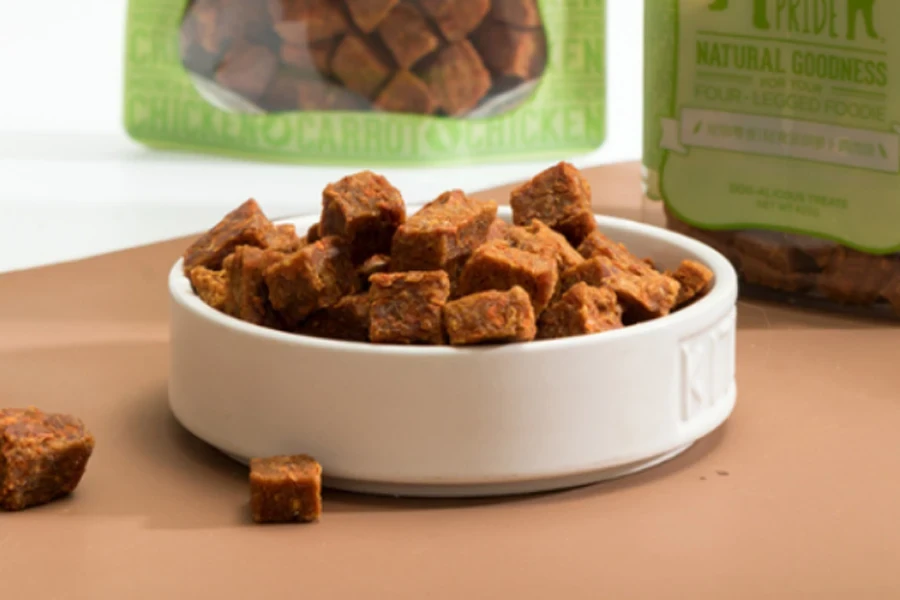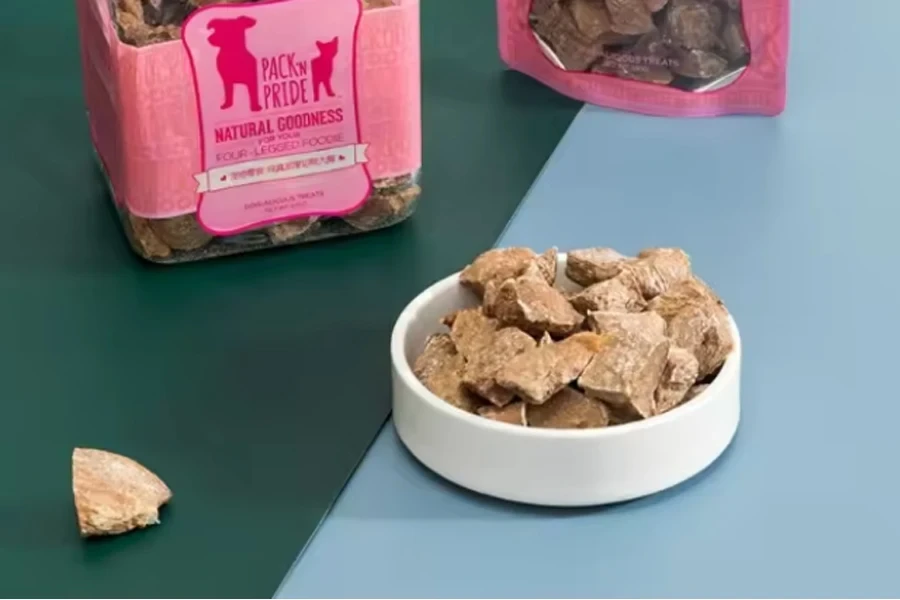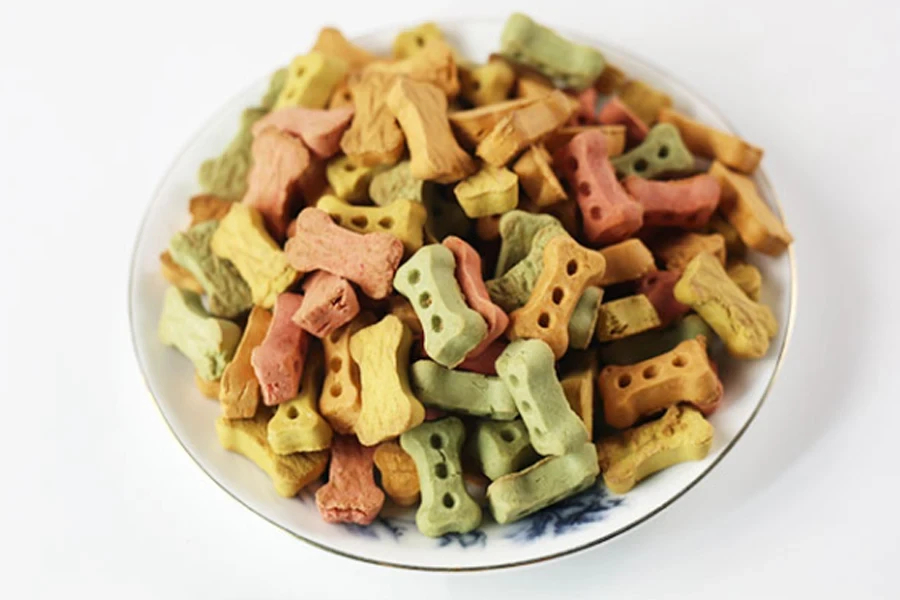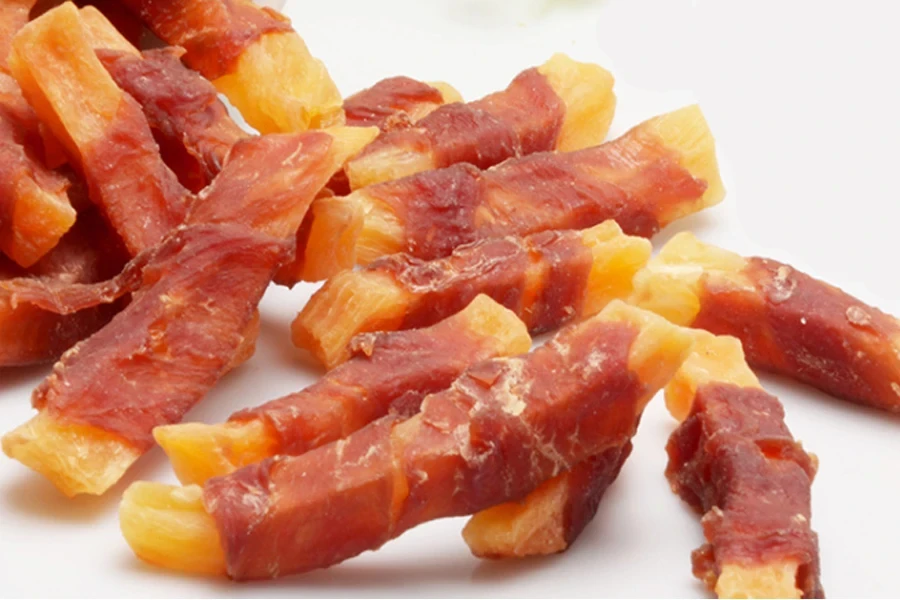In 2024, the landscape for dog treats is undergoing a significant transformation, with a noticeable pivot towards products that not only delight but also deliver distinct health benefits. This shift is driven by an enhanced understanding of canine nutrition and a growing demand for treats that support a dog’s overall well-being. Consumers are increasingly seeking out treats that are nutritious, made with high-quality ingredients, and cater to the specific needs of their pets, from dental health to dietary supplements. This evolution reflects a broader trend in pet care, where the emphasis is on proactive health management through thoughtful, purposeful treat selection.
Table of Contents
1. Types and applications of dog treats
2. 2024 Dog treat market insights
3. Criteria for choosing superior dog treats
4. Top treat picks and their features
5. Conclusion
Types and applications of dog treats

As the pet care sector advances into 2024, the segmentation of dog treats reflects a nuanced understanding of canine health and behavior needs. The diversification in treat offerings caters to distinct objectives, ranging from health enhancement to training support, and indulgence with gourmet options, mirroring a heightened consumer expectation for specificity and quality in pet products.
Nutritional and functional treats
The domain of nutritional and functional dog treats has witnessed significant innovation, as pet owners increasingly seek products that contribute positively to their pets’ health. Beyond mere indulgence, these treats are formulated to serve specific health-related purposes. For example, dental treats have become a staple in preventive oral care routines for dogs. Products like Greenies, recognized by veterinary dental associations, are scientifically proven to reduce tartar buildup by up to 60%, showcasing the efficacy of well-formulated functional treats. Similarly, the market has seen a rise in treats infused with omega-3 fatty acids, glucosamine, and chondroitin, targeting joint health and mobility. These supplements, once relegated to pill form, are now seamlessly integrated into palatable treats that dogs eagerly consume, simplifying the process for pet owners to manage conditions like arthritis and hip dysplasia.
Another burgeoning segment within this category is that of probiotic treats aimed at enhancing digestive health. With gastrointestinal issues being common among canines, treats containing beneficial bacteria can help balance gut flora, thereby improving digestion and nutrient absorption. This functional approach to treat formulation represents a broader shift towards holistic pet wellness, where every product choice is an opportunity to support overall health.
Training and behavioral treats

In the realm of dog training, the significance of the right treat cannot be overstated. Training treats are a cornerstone of positive reinforcement techniques, serving as a powerful motivator for dogs during training sessions. The effectiveness of these treats hinges on their size, palatability, and nutritional content. Small, low-calorie treats are preferable, as they allow for repeated rewards without the risk of weight gain. This is particularly crucial in intensive training scenarios where treats are dispensed frequently.
Moreover, the composition of training treats plays a role in their appeal. For instance, treats with a high protein content and aromatic ingredients are often more enticing to dogs, ensuring their undivided attention during training exercises. Brands like Zuke’s Mini Naturals have capitalized on this, offering treats that are not only size-appropriate and low in calories but also rich in flavor, making them ideal for training purposes. The use of real chicken, lamb, or salmon as the primary ingredient ensures that these treats are both nutritious and highly palatable.
Furthermore, the evolution of training treats has also embraced the concept of limited-ingredient products, catering to dogs with food sensitivities or allergies. This inclusivity enables all dogs to participate in training activities without compromising their health, illustrating the pet care industry’s move towards more thoughtful and inclusive product development.
Specialty and gourmet treats

The pet treat sector has seen a notable rise in specialty and gourmet offerings, a trend driven by pet owners’ desires to provide their furry companions with the same quality of food they would choose for themselves. This category encompasses a wide array of products designed to cater to specific dietary needs, taste preferences, and even luxury indulgences for pets.
One compelling example within this category is the emergence of organic dog treats. These products appeal to pet owners looking for treats made from ingredients grown without synthetic pesticides or fertilizers. Brands like Honest Kitchen offer a range of dehydrated, organic treats that promise a level of purity and simplicity akin to homemade food, ensuring pets receive treats free of unnecessary additives.
Grain-free treats have also surged in popularity, catering to dogs with grain sensitivities or allergies. These treats substitute traditional grains with alternative sources of carbohydrates like sweet potatoes or legumes, offering a healthier snack option that’s easier on the digestive system. Blue Buffalo’s Wilderness Trail Treats are a prime example, offering grain-free snacks that don’t compromise on flavor or nutritional value.

Gourmet treats represent the pinnacle of luxury in the dog treat market, often featuring high-quality, human-grade ingredients that could easily find their place in a fine dining restaurant. Brands like Bocce’s Bakery have carved out a niche in this space, offering limited-ingredient treats with artisanal flavors such as Truffle Mac & Cheese or Beef Bourguignon, elevating the treat experience to new heights.
Moreover, the specialty segment has expanded to include treats catering to unique dietary needs, such as low-calorie options for weight management or recipes enhanced with supplements for joint health, skin care, and cognitive function. This bespoke approach to dog treats underscores a growing recognition of pets’ varied nutritional needs and the desire among owners to address these needs through targeted, high-quality products.
The appeal of specialty and gourmet treats lies not just in their nutritional benefits but also in the joy and enrichment they bring to pets’ lives. Whether it’s a simple pleasure like a grain-free biscuit or a luxurious bite of gourmet jerky, these treats serve as an expression of care and indulgence, strengthening the bond between pets and their owners.
In summary, the dog treat market reflects a broader trend towards personalization and premiumization in pet care, with pet owners increasingly seeking out products that align with their values and aspirations for their pets’ well-being. As this segment continues to evolve, it’s likely we’ll see even more innovation and diversification, catering to the ever-expanding palette of pet dietary preferences and needs.
2024 Dog treat market insights

The landscape of the dog treat market in 2024 is a reflection of a broader societal shift towards health consciousness and wellness, not just for humans but for their pets as well. This change is influencing both the development of new products and the demand patterns observed across the industry.
Market growth and preference shifts
The dog food market, including the dog treat market, is projected to show significant growth, with experts forecasting its expansion from USD 96.33 billion in 2024 to reach USD 156.60 billion by 2029. This growth trajectory represents a Compound Annual Growth Rate (CAGR) of 10.21% during the forecast period. This substantial growth is attributed to various factors, including the increasing dog population, enhanced awareness among pet owners regarding the nutritional needs of their pets, and a general trend towards premium pet food products with specific health benefits. Major companies such as Colgate-Palmolive Company (Hill’s Pet Nutrition Inc.), General Mills Inc., Mars Incorporated, Nestle (Purina), and The J. M. Smucker Company are key players in driving innovations and expansions in this market.
An increased awareness of pet health and wellness is at the forefront of shaping dog treat preferences. Pet owners are now more knowledgeable about the dietary needs of their pets and are seeking treats that support rather than compromise their dog’s health. This awareness has led to innovation in treat formulations, with a significant emphasis on natural ingredients, functional benefits, and dietary restrictions. For example, the demand for treats with added health benefits, such as those containing supplements for joint health or probiotics for digestive wellness, has seen a notable uptick. This trend towards functional treats is not just a fad but a reflection of pet owners’ desire to proactively contribute to their pets’ longevity and quality of life.
Demand analysis

The demand for high-quality, health-conscious treats is on the rise, influencing both market growth and product diversity. This surge is driven by consumers’ increasing preference for treats made from wholesome, easily recognizable ingredients, with minimal processing. The market has responded with an array of options catering to various health concerns and dietary preferences, including organic, grain-free, and limited-ingredient treats. This diversification has not only expanded the choices available to consumers but also intensified competition among brands to innovate and capture the attention of health-savvy pet owners.
The demand for such products has also led to an expansion in retail distribution channels, with pet specialty stores, online retailers, and even grocery and health food stores increasing their dog treat offerings. The result is a dynamic market where growth is not just measured in sales figures but also in the variety and quality of products available to consumers. The pet treat market’s evolution is indicative of a larger trend in pet care, where the health, happiness, and well-being of pets are paramount. This shift towards quality and specificity in dog treats is expected to continue, shaping the industry’s future and offering new opportunities for brands and retailers to meet the sophisticated needs of today’s pet owners.
In summary, the dog treat market in 2024 stands at the intersection of health and innovation, with consumer preferences driving a shift towards more specialized, health-focused products. As the market grows and evolves, it reflects a deeper understanding of pet care, where every treat is an opportunity to enhance a pet’s well-being.
Criteria for choosing superior dog treats

In the competitive landscape of the pet care industry, discerning the criteria for selecting superior dog treats is paramount for businesses aiming to cater to the evolving demands of pet owners. These criteria not only reflect the growing sophistication in pet nutrition but also underscore the industry’s commitment to pet health and safety.
Ingredient quality and nutritional value
The quality of ingredients and their nutritional value play a pivotal role in the selection of superior dog treats. As the pet food industry evolves, there’s a marked shift towards incorporating whole-food ingredients that closely mimic a natural, ancestral diet for dogs. This shift is driven by the understanding that whole-food ingredients provide a more bioavailable source of nutrients, meaning the body can absorb and utilize these nutrients more efficiently than synthetic alternatives.

Whole-Food Ingredients
Whole-food ingredients are those that are minimally processed and remain as close to their natural state as possible. Examples include real meats (like chicken, beef, or fish) as the primary protein source, vegetables (carrots, peas), fruits (blueberries, apples), and whole grains (brown rice, barley). These ingredients offer essential vitamins, minerals, and antioxidants that support overall health, from immune function to skin and coat quality.
For instance, treats that list real chicken or beef as the first ingredient provide high-quality protein that supports muscle maintenance and energy levels. Fruits and vegetables, meanwhile, supply natural fibers, antioxidants, and phytonutrients that aid in digestion and can help reduce inflammation. The inclusion of whole grains in treats offers a source of complex carbohydrates for sustained energy, alongside fiber for gastrointestinal health.

Functional Benefits
Beyond basic nutrition, there’s growing interest in dog treats that offer functional benefits—those that serve a specific health purpose. Treats infused with omega-3 fatty acids (from sources like fish oil) are sought after for their anti-inflammatory properties and their role in maintaining healthy skin and a shiny coat. Similarly, treats containing glucosamine and chondroitin support joint health and mobility, especially beneficial for aging dogs or those prone to joint issues.
Another emerging trend is the incorporation of probiotics into dog treats. Probiotics are beneficial bacteria that promote a healthy gut microbiome, enhancing digestion and nutrient absorption. Treats formulated with these ingredients not only serve as a tasty snack but also contribute to the dog’s overall well-being, addressing common health concerns from within.

Transparency and Labeling
The demand for transparency in labeling reflects a broader desire among pet owners to understand exactly what they are feeding their pets. Superior dog treats are characterized by clear, straightforward ingredient lists that allow owners to easily identify and understand the inclusion of each item. This transparency is crucial for dogs with specific dietary needs or sensitivities, enabling owners to make informed choices that align with their pet’s health requirements.
In summary, the selection of dog treats based on ingredient quality and nutritional value is a testament to the growing sophistication in pet nutrition. By prioritizing whole-food ingredients and functional benefits, and demanding transparency in labeling, pet owners can ensure they are providing their canine companions with treats that not only satisfy but also nourish.
Safety and allergen considerations

When selecting superior dog treats, safety and allergen considerations are paramount. This focus ensures that treats not only provide enjoyment and nutrition but also safeguard the health of pets by minimizing the risk of adverse reactions and ensuring product safety.
Identifying and Avoiding Common Allergens
Allergies in dogs can manifest as skin irritations, gastrointestinal upset, or respiratory issues, often triggered by specific ingredients in their diet. Common allergens include beef, dairy, wheat, egg, chicken, lamb, soy, pork, rabbit, and fish. As such, selecting dog treats that are free from these common allergens—or alternatively, choosing single-protein treats or those made from novel protein sources like kangaroo, venison, or insect protein—can significantly reduce the risk of allergic reactions.
Manufacturers are increasingly recognizing the importance of catering to dogs with food sensitivities. For example, limited-ingredient treats have gained popularity for their simplicity and transparency, featuring a minimal number of components and clearly highlighting the protein source. This approach allows pet owners to easily identify treats that align with their dog’s dietary restrictions and avoid potential allergens.

Steering Clear of Harmful Additives
The safety of dog treats is also closely linked to the use of additives and preservatives. While some additives are necessary for ensuring product shelf-life, others can be harmful or unnecessary. Artificial colors, flavors, and preservatives such as BHA, BHT, and ethoxyquin have come under scrutiny for their potential health risks. In response, there is a growing preference for treats preserved with natural alternatives like tocopherols (vitamin E), rosemary extract, and ascorbic acid (vitamin C), which are considered safer for canine consumption.
Pet owners and professionals in the industry are urged to scrutinize ingredient lists for the presence of these additives. Choosing treats with natural, recognizable ingredients not only contributes to safety but also aligns with a holistic approach to pet wellness.
Ensuring Compliance with Safety Standards
Beyond individual ingredients, the overall safety of dog treats is contingent upon compliance with industry standards and regulations. Reputable manufacturers adhere to stringent quality control measures and are often certified by regulatory bodies such as the Association of American Feed Control Officials (AAFCO) or carry certifications like the Global Food Safety Initiative (GFSI). These certifications are indicative of a commitment to safety and quality, providing an additional layer of assurance to pet owners.
It’s also advisable for businesses and consumers to stay informed about product recalls and safety alerts. These can serve as critical indicators of potential safety issues within the industry and guide more informed treat selections.
In conclusion, safety and allergen considerations require a multifaceted approach, involving careful selection of ingredients, avoidance of harmful additives, and adherence to safety standards. By prioritizing these aspects, businesses and pet owners can ensure that the dog treats they choose are not only enjoyable but also contribute positively to the health and well-being of pets.
Palatability and acceptance

The palatability and acceptance of dog treats are critical factors that significantly influence their success and desirability among pets. These aspects determine not just how eagerly a treat is received but also its effectiveness as a tool for training and bonding. Palatability encompasses the taste, aroma, and texture of the treat, all of which play a vital role in how well a treat is accepted by a dog.
Taste and Aroma
Dogs have specific taste preferences, with a strong inclination towards meaty flavors due to their carnivorous nature. Treats that are rich in high-quality animal proteins tend to be more appealing. For instance, treats made with real chicken, beef, or fish as the primary ingredient are often more enticing than those based on fillers or artificial flavors. The aroma of the treat also plays a crucial role, as dogs have a highly developed sense of smell. Treats that emit a strong, pleasant, meaty smell are likely to be more attractive to dogs, enhancing their overall acceptability.

Texture Variety
Texture is another important consideration, with preferences varying widely among individual dogs. Some may prefer the crunchiness of a biscuit that can help with dental cleaning, while others may favor softer, chewy treats that are easier to eat, especially for puppies or senior dogs with dental issues. Offering a variety of textures caters to a broad spectrum of preferences, ensuring that there are options available for every dog, regardless of age, breed, or health condition.
Dietary Restrictions and Sensitivities
Palatability must be balanced with the consideration of dietary restrictions and sensitivities. For dogs with specific health issues or food intolerances, the selection of treats must take into account these dietary needs. Hypoallergenic treats, which avoid common allergens like wheat, soy, and artificial additives, can provide a safe option for sensitive dogs without sacrificing taste. Similarly, treats formulated with novel protein sources or limited ingredients can offer palatable alternatives that minimize the risk of allergic reactions.

Enhancing Acceptance
Enhancing the acceptance of dog treats beyond taste, aroma, and texture involves incorporating nutritional benefits that support overall health without compromising palatability. This can include adding functional ingredients like probiotics, vitamins, and minerals that provide additional health benefits. Manufacturers are increasingly innovating in this space, creating treats that not only taste good but also contribute to the dog’s well-being, making them an integral part of a balanced diet.
In conclusion, ensuring treats are appealing and acceptable involves a delicate balance of taste, aroma, texture, and nutritional content, tailored to meet the diverse needs and preferences of dogs. By focusing on high-quality, flavorful ingredients, offering a variety of textures, and considering dietary restrictions, businesses can cater to the wide range of dog tastes, enhancing the bond between pets and their owners through the joy of a well-received treat.
Top treat picks and their features

The pet care market’s evolution reflects a growing emphasis on specialized nutrition and indulgence, leading to the emergence of specialty treat picks that cater to various health needs and gourmet preferences.
Innovative functional treats
Innovation in functional treats has transformed the pet treat landscape, introducing products with specific health benefits. Ingredients like glucosamine for joint support, omega fatty acids for coat health, and probiotics for digestive wellness are becoming standard. These ingredients are not randomly chosen; they are backed by veterinary science to address common health concerns in dogs. For example, treats infused with glucosamine and chondroitin are targeted at senior dogs or breeds prone to joint issues, providing them with the necessary supplements to maintain mobility and joint health. Similarly, treats rich in omega fatty acids not only improve the skin and coat condition but also support cognitive function, making them ideal for dogs across all life stages.

Greenies Regular Dog Dental Treats: Dental health is as crucial for dogs as it is for humans, and Greenies Dental Treats address this need head-on. Approved by the Veterinary Oral Health Council, these treats are proven to reduce plaque and tartar build-up, contributing to healthier gums and fresher breath. Their formulation includes easy-to-digest ingredients, alongside a blend of vitamins and minerals, to offer more than just dental benefits. This comprehensive approach to canine oral health makes Greenies a favorite among pet owners who are keen on maintaining their dog’s dental hygiene without the stress of traditional brushing.
Pet Botanics Training Reward Bacon-Flavored Dog Treats: Specifically designed for training, these bacon-flavored treats are a hit among dogs for their taste and among trainers for their functionality. With just 3 calories per treat, they allow for repetitive rewarding without the risk of overfeeding, making them an ideal choice for lengthy training sessions. The key ingredient, real pork liver, not only provides a rich flavor but also packs a nutritional punch. The small size and low calorie count make these treats perfect for continuous positive reinforcement, ensuring that training remains both effective and healthy.

Zuke’s Hip Action Hip & Joint Natural Dog Treats: Recognizing the importance of joint health in dogs, especially in older or active breeds, Zuke’s Hip Action treats are formulated to support hip and joint wellness. Infused with eggshell membrane, a natural source of glucosamine and chondroitin, these treats aid in maintaining joint flexibility and mobility. The inclusion of wholefood berries, vitamins, and minerals ensures that these treats are as nutritious as they are beneficial. Available in both beef and chicken flavors, they offer a tasty solution to a common canine health concern, making them a favorite among health-conscious pet owners.
Blue Buffalo Blue Bits: Blue Bits are soft, heart-shaped treats that are slightly larger than typical training treats, making them suitable for larger dogs. The first ingredient in each flavor is real meat protein, paired with brown rice or oatmeal. Blue Bits also contain omega fatty acids like DHA to support skin and coat health. Made in the United States, these treats contain no artificial preservatives, colors, or flavors, ensuring a healthy and tasty option for rewarding your dog.

Jiminy’s Chewy Cricket Treats: An eco-friendly and nutritious option, Jiminy’s Chewy Cricket Treats use crickets as the main protein source. Crickets offer higher nutrition than traditional meats, including more protein, fiber, iron, and omega-3 fatty acids, while being more sustainable and environmentally friendly. These treats come in various flavors, featuring a mix of crickets and fruits and vegetables like sweet potato, pumpkin, and blueberries. They are free from wheat, corn, soy, and other fillers, making them a good choice for dogs with beef or chicken sensitivities.
Gourmet and artisanal options
The rise of gourmet and artisanal treats reflects a broader trend towards premiumization in pet care. These treats often feature high-quality, human-grade ingredients, offering a sensory experience that appeals to both pets and their owners. Artisanal treats are typically handcrafted and come in unique flavors and textures, distinguishing them from mass-produced options. Ingredients like grass-fed beef, free-range chicken, or organic vegetables signal quality and care in production, catering to pet owners who seek the best for their companions. Brands specializing in these gourmet options often emphasize their natural, preservative-free recipes, appealing to health-conscious consumers.

Rachael Ray Nutrish Burger Bites: Inspired by celebrity chef Rachael Ray’s kitchen creations, these beef-flavored treats bring a gourmet touch to the dog treat segment. Crafted to mimic the taste and texture of real burgers, these treats are made with farm-raised beef as the first ingredient, ensuring a high-quality protein source. The soft texture makes them suitable for dogs of all ages and sizes, and their easy-to-break nature allows pet owners to adjust portion sizes as needed. Free from artificial flavors and meat by-products, Nutrish Burger Bites cater to pets with sensitive stomachs, providing a wholesome, delicious treat option.
Pup-Peroni Rounds Beef Brisket Dog Treats: Pup-Peroni Rounds are designed to offer a unique, savory experience with their beef brisket flavor, catering to dogs’ natural preference for meaty tastes. The round, pepperoni-like shape adds an element of fun to treat time, while the real beef ingredient ensures a treat that’s both tasty and nourishing. These treats are free from artificial flavors, fillers, and added grains, making them a straightforward, enjoyable choice for pet owners looking to indulge their pets with a straightforward, meat-centric snack.

Canine Carry Outs Dog Treats: Canine Carry Outs stand out for their impressive range of flavors, designed to cater to the diverse tastes of dogs everywhere. This brand understands that variety is the spice of life, even for our canine companions, and has developed a line of treats that ensures every dog can find a flavor they love. From classic meaty tastes to more unique offerings, these treats keep snack time exciting and engaging. Ideal for use in training or as an everyday treat, Canine Carry Outs provide a convenient and enjoyable way to reward pets, encouraging positive behavior and strengthening the bond between dogs and their owners.
Old Mother Hubbard Mini Biscuits: These bone-shaped biscuits are an ideal size for smaller dogs or for use as training treats. Available in several flavors and assortments, they offer a satisfying crunch with a short list of natural ingredients, including peanut butter, chicken liver, and various fruits and vegetables. There are no artificial preservatives or byproducts in these treats. The recipe for Old Mother Hubbard treats dates back to 1926 and is oven-baked to create a crunchy texture that dogs love.

PetPlate’s Chicken Apple Sausage Bites: These gourmet-style treats blend high-quality chicken with the sweet tanginess of apples to create a sausage bite that’s both nutritious and irresistibly tasty. Crafted with USDA-certified organic ingredients, these treats not only promise a clean, wholesome snack but also reflect a commitment to sustainable and ethical farming practices. The Chicken Apple Sausage Bites are designed with both palatability and health in mind, providing a source of lean protein and fiber. Their easy-to-break nature makes them perfect for portion control and training, offering a versatile treat that suits dogs of all sizes and dietary needs.
Small, Family-Run Business Jerky Sticks: Produced by a small, family-operated business, these jerky sticks bring a personal touch to the dog treat market. Using only real meat as the main ingredient, these treats offer a pure, unadulterated protein source that dogs instinctively crave. The smoky flavor, achieved by smoking the treats over hickory wood, adds an extra layer of taste that’s bound to captivate any canine’s palate. Free from artificial flavors and fillers, these jerky sticks represent a return to simple, honest ingredients, providing a snack that’s as close to nature as possible.
Diet-specific treats

Diet-specific treats address the diverse dietary needs and restrictions of dogs, from allergies and sensitivities to weight management. Limited-ingredient treats, for instance, are designed with simplicity in mind, using a minimal number of ingredients to minimize the risk of allergic reactions. Hypoallergenic options go a step further, excluding common allergens like grains, soy, and artificial additives, providing a safe snacking option for sensitive dogs. For pets on a weight management plan, low-calorie treats that are satisfying without being fattening are crucial. These treats often leverage high-fiber ingredients to promote satiety, helping dogs maintain a healthy weight without feeling deprived.
Hill’s Natural Baked Light Biscuits: These treats stand out as an excellent choice for pet owners looking to maintain their dog’s weight without compromising on taste. The chicken-flavored, low-calorie biscuits are crafted to avoid adding unnecessary calories to your pet’s diet, making them an ideal treat for weight-conscious pets or those on a restricted calorie intake. Free from corn, artificial colors, and flavors, these biscuits adhere to stringent nutritional guidelines to ensure they fit within a balanced diet, as recommended by the Association of American Feed Control Officials (AAFCO). Available in small and medium sizes, they cater to dogs of various breeds and sizes, ensuring a safe and enjoyable treat experience.

Zuke’s Mini Naturals Chicken Recipe Dog Training Treats: These treats are specially designed for training sessions, offering a healthy, low-calorie reward that doesn’t distract from dietary goals. Their small size makes them perfect for repetitive rewards without overfeeding. Formulated without wheat or corn, these treats are an excellent option for dogs with dietary sensitivities or allergies. The absence of added animal fats, artificial colors, and flavors underscores their commitment to natural, wholesome ingredients. The main ingredient, real chicken, ensures that these treats are not only healthy but highly palatable and motivating for dogs during training exercises.
JustFoodForDogs Treats: Elevating the standard for dog treats, JustFoodForDogs Treats are meticulously crafted using only the finest, fresh, whole-food ingredients. This brand stands out for its commitment to transparency and quality, offering treats that are not just palatable but also nutritionally beneficial. These treats are an excellent choice for pet owners who prioritize a natural diet for their dogs, mirroring the quality of human-grade food. The emphasis on healthful ingredients ensures that dogs are not only satisfied but are also receiving essential nutrients, making these treats a guilt-free option for rewarding or snacking.

Pur Luv Jerky Dog Treats: Simplifying the snack time, Pur Luv’s Jerky Dog Treats feature a minimalist approach, boasting only three key ingredients. This simplicity caters to the growing demand for clean, uncomplicated pet foods, ensuring that dogs of every size and breed can enjoy a high-protein treat without the worry of hidden fillers or artificial additives. Ideal for dogs with dietary restrictions or sensitive stomachs, these treats provide a wholesome and satisfying experience, enhancing the bond between pet and owner through the joy of a simple, delicious reward.
Blue Dog Bakery Natural Dog Treats: Blue Dog Bakery’s Natural Dog Treats, particularly popular in peanut butter flavor, strike the perfect balance between taste and nutrition. These treats are crafted with an unwavering commitment to natural ingredients, ensuring that every bite is free from artificial preservatives, colors, and flavors. The appeal of these treats lies not only in their irresistible taste but also in their health benefits, making them a favorite among dogs and a trusted choice for their owners. Whether used as a training aid or a special snack, these treats are designed to support the overall well-being of dogs, contributing to their happiness and health.
Each product offers a unique blend of flavors, textures, and nutritional benefits, catering to a wide range of preferences and dietary needs. From eco-friendly protein sources to traditional baked biscuits and soft, meaty treats, these options provide healthy and tasty rewards for dogs of all shapes and sizes.

The specialization of dog treats into these categories illustrates the pet care industry’s shift towards personalization and health-centric nutrition. As consumers become more informed and discerning in their choices, the demand for treats that offer more than just taste is growing. These specialty picks not only enrich the lives of pets with delicious flavors and textures but also support their health and well-being through carefully selected, beneficial ingredients.
Conclusion
As the pet care landscape evolves, the selection of dog treats in 2024 has become a nuanced decision, reflecting a deep understanding of health, nutrition, and market trends. The emphasis on ingredient quality, safety, palatability, and the ability to meet specific dietary needs highlights the industry’s shift towards more conscientious pet care. With the market expanding to include innovative functional, gourmet, and diet-specific options, professionals are tasked with choosing wisely from a plethora of available products, ensuring that the treats they offer not only satisfy but also contribute positively to the well-being of pets, reinforcing the bond between pets and their owners through thoughtful nutrition.








